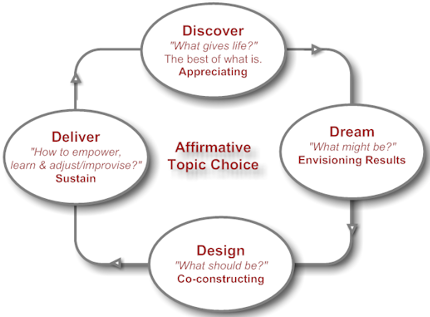How does the 4-D process work?
An Appreciative Inquiry typically goes through the following four stages:
Discover – Appreciating and valuing the best of What Is. Information and stories are gathered about what is working well.
Dream – Envisioning What Might Be. How do we want things to be for the future?
Design – Determining What Should Be. How can we move from where we are now to this vision of the future that we have created? How can we put the ideas into practice? Who will be involved?
Deliver (or Destiny) – Innovating What Will Be. In this phase, practical strategies or projects are put into practice and space created for ideas to flow and develop. There is an emphasis on empowering and encouraging people to take action and carry forward their own ideas.
So what does this look like in practice?
Appreciative Inquiry principles and practices are adapted and customized to each individual situation. We work with our clients to develop an approach that meets their needs within available resources and timeframes. This does not always mean following the 4-D process in its entirety.
The full process typically includes:
- Select a focus area or topic(s) of interest.
This is often (though not always) done by a core group of people volunteering or selected to drive the Appreciative Inquiry process.
- Conduct interviews designed to discover strengths, passions and unique attributes.
Typically stakeholders and participants interview one another. This is a much more powerful catalyst for positive change than having an “outsider” conduct the interviews.
- Identify patterns, themes and/or intriguing possibilities.
Most often this takes place at a large group or community meeting – frequently called a summit. Ideally all stakeholders are brought together so all voices are in the same room. This maximises the impact of summit conversations.
- Create bold statements of ideal possibilities.
These are often called Provocative Propositions and are designed to stretch the imagination into the desired future. This step goes beyond traditional goal-setting approaches. It actively and intentionally encourages innovation and appropriate risk taking. This is what it means to make bold statements of ideal possibilities.
- Co-determine what should be, reach consensus on principles and priorities and plan practical action steps.
This is about translating into practical action the positive stories gathered through the interview process, along with the dreams and hopes of participants expressed in the provocative propositions. This step also deals with the practicalities – the nuts and bolts of what we will do to make things even better. What do we have the energy and commitment to do right here and now, to move towards the future we want?
- Take/sustain action.
Not only is it important to implement agreed actions, but to incorporate time and opportunity for reflection, evaluation and celebration. Sharing what has changed, what is going better and/or what more we could do to reach our desired future – all these things help us to sustain the energy for positive change. This step becomes part of the continuous improvement cycle that is Appreciative Inquiry.

 Our monthly newsletter
Our monthly newsletter